#shanghai institute of visual arts
Explore tagged Tumblr posts
Text
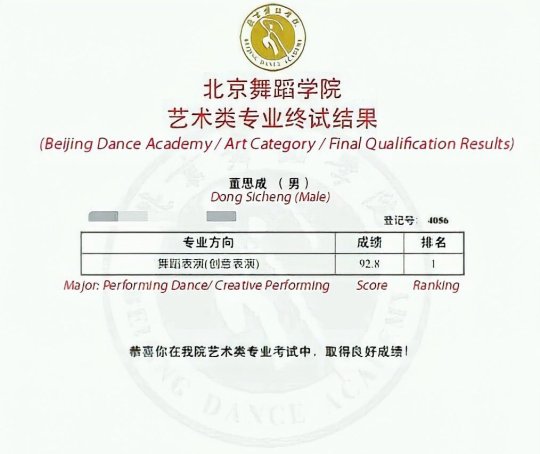
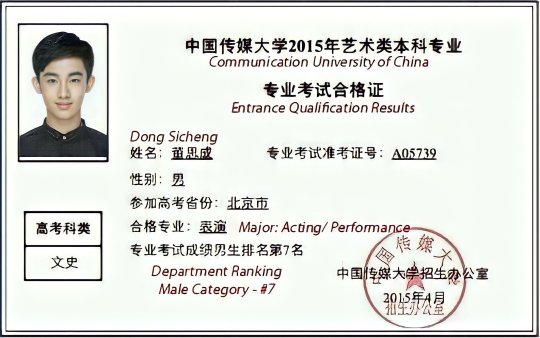
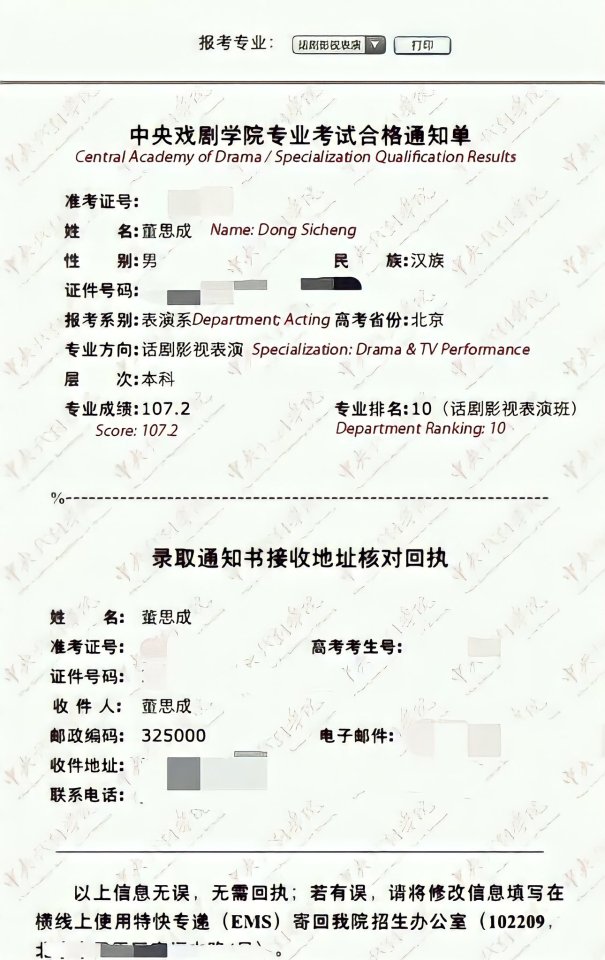

Winwin’s Exam Results & his rank from 4 Prestigious Schools #1 北京舞蹈学院 Beijing Dance Academy #7 中国传媒大学 Communication University of China #10 中央戏剧学院 Central Academy of Drama #12 上海视觉艺术学院 Shanghai Institute of Visual Arts
#winwin#dong sicheng#윈윈#董思成#wayv#nct#dance academy#communication university#central academy of drama#zhongxi#shanghai institute of visual arts#wayv winwin#nct winwin
41 notes
·
View notes
Text
Link Click Musical update 141 🥳🧡💙
(it's Shu Rongbo AND Wu Yihan's birthday! Have trivia abt them)

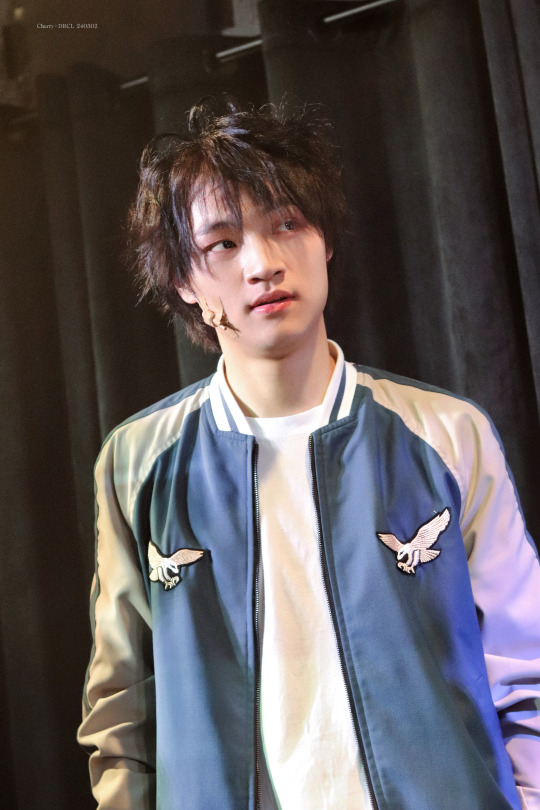


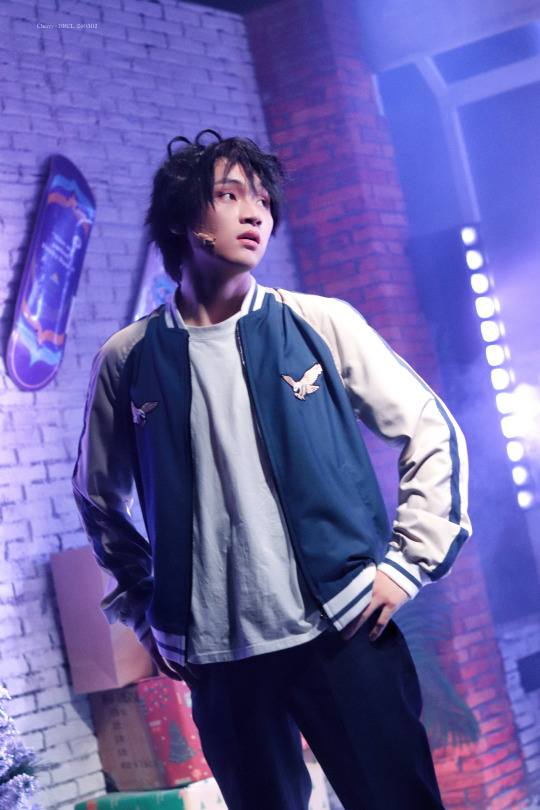
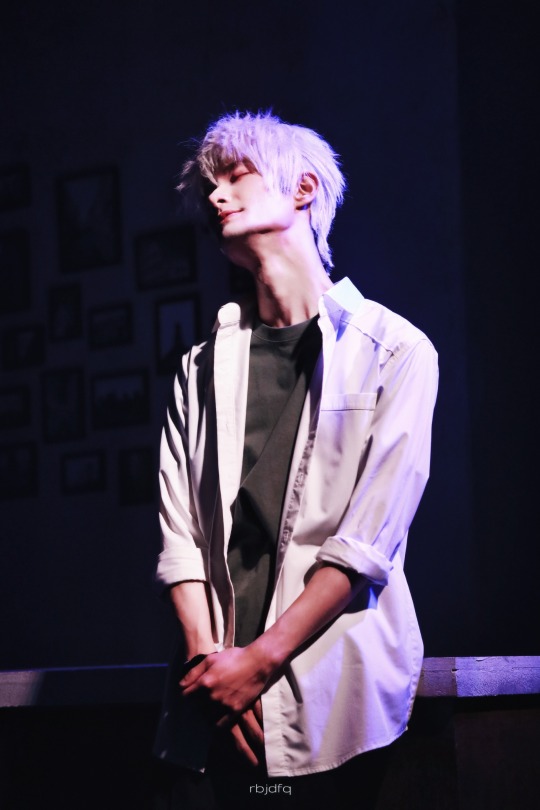
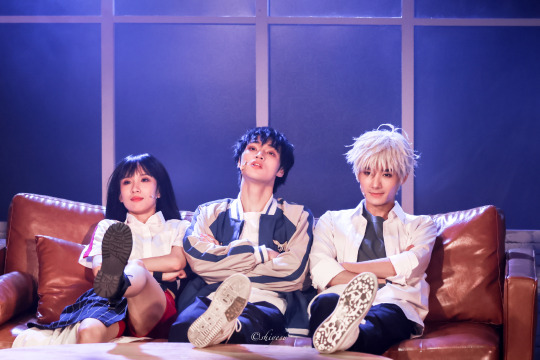
Check Encore Musicals weibo for the birthday clip 🥳🌟
Since you were curious about Shu Rongbo & I already had Wu Yihan trivia on hand, I thought their birthday would be a perfect time to share it all 💙🧡
Big thanks to my sweet @chocolatexiaoshi who researched Shu Rongbo on my request 💗
(side note: srb is a young, rising actor, so sorry that the amount of information I have here isn't proportional :< )




Shu Rongbo (23 yo)
Born in 2001, March 10th, in Leshan in Sichuan Province
Graduated from Shanghai Institute of Visual Arts in 2018
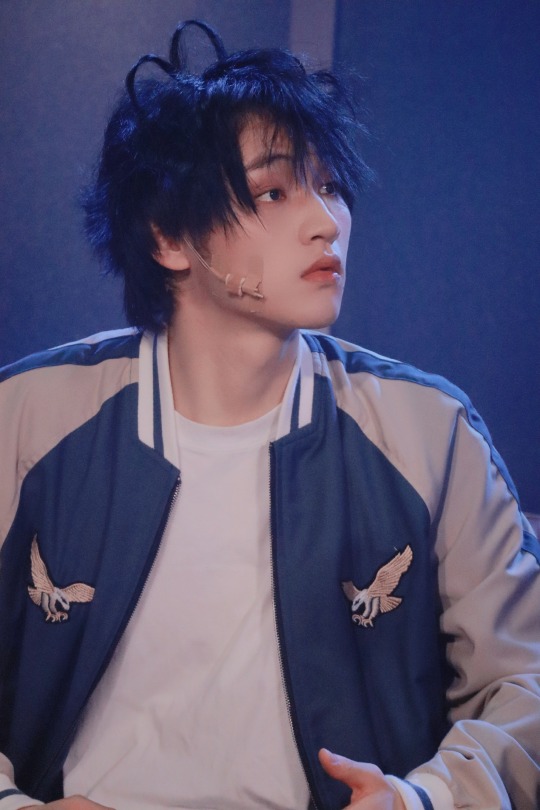


audience members compliment his beautiful voice and acting skills that noticeably improved over the course of LC Musical
since he's from Sichuan, where the earthquake actually happened his CXS is praised for wanting to 'fullfil regrets very conscientiously'; meaning his performance during the earthquake plotline feels authentic for the audience
he used to play Stevie in Mio Fratello musical (the mafia one where WYH plays Sonny Boy & lady Florence), turns out the picture below is from his last performance of that character (not a uni graduation like I thought first ^^')
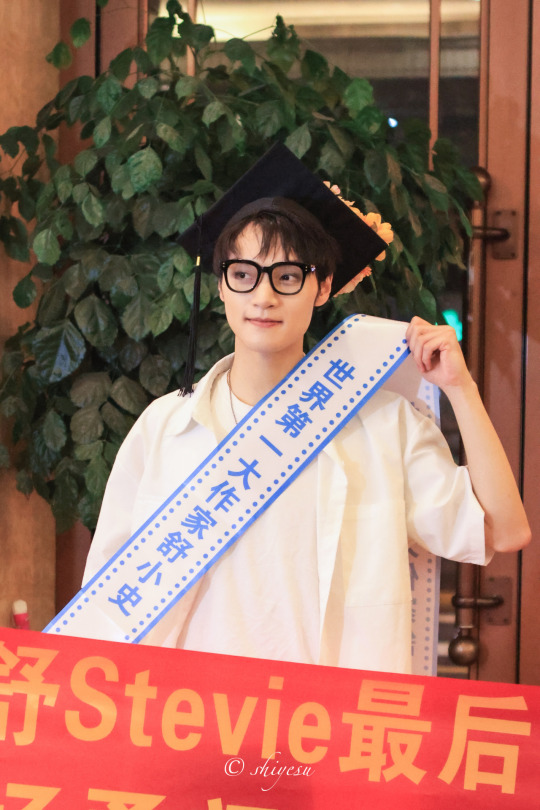
Intermission: This glorious pictures are from srb's weibo. It was a photoshoot for 'Love' /#��乐剧致爱# musical. They (and Bai Zhuoming too btw) play the same character.

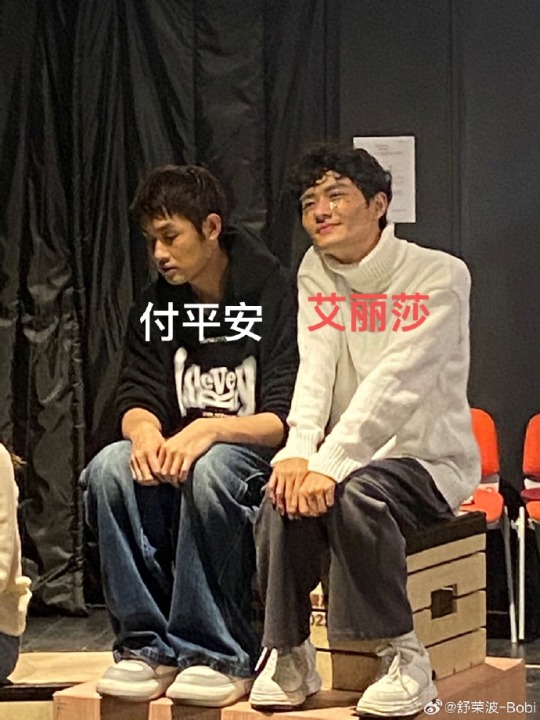


✨✨✨ ✨✨✨✨✨✨✨✨✨✨✨✨✨✨✨✨✨
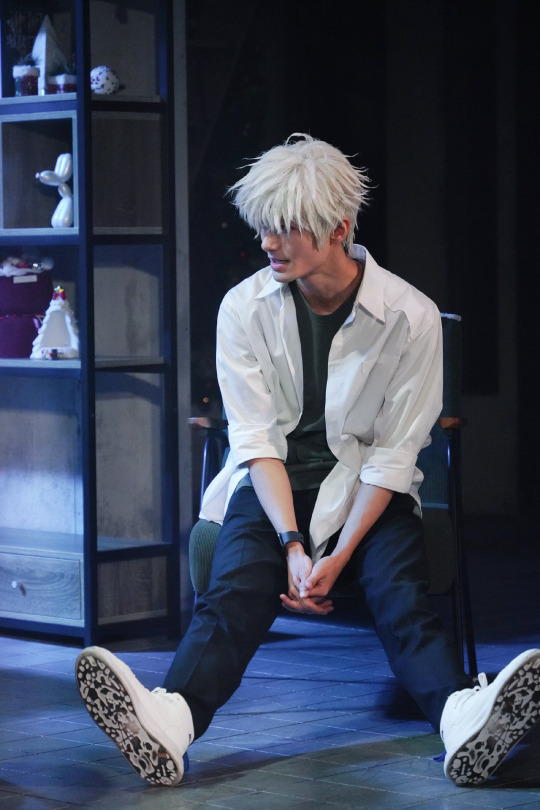



Wu Yihan (27 yo)
his mbti type is INFP
Wang Haonan, friend from Mio Fratello cast, did a Q&A with him. Through an abysmal method of screenshotting chinese subtitles and image translating I've learned that: he isn't fond of doing 'stage door (sd)' interviews and usually prefers to go home immediately after the performance (I'm not 100% confident what he said, I'll link the video so you can try fact check it)
he has a cat named Yǎo咬 (which I think means 'Bite'); wyh's friend was catsitting him once and posted those pictures, saying the cat sleeps just like his owner.

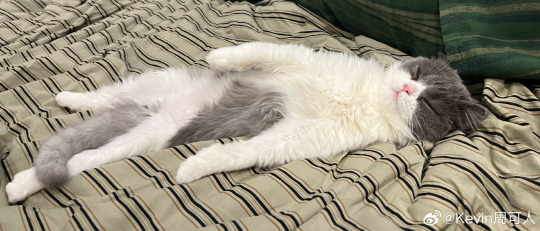
to which WYH replied with this:
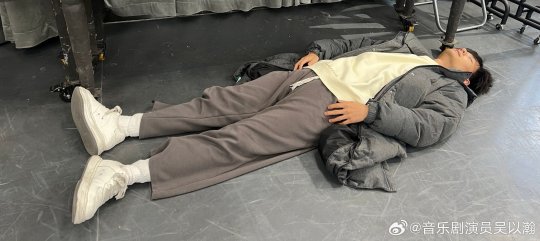
+ other actor friends commented these:


(idk I just loved this exchange)
he smokes (don't smoke kids, it'll never be as aesthetic as WYH anyway)


Okay, so atp there aren't many posts from their March 10th night performance, bc it ended not too long ago and now it's a late night in China >< I'll make another post about it when I gather enough materials o7
#link click#link click musical#shiguang dailiren#lu guang#cheng xiaoshi#wu yihan#shu rongbo#source: weibo#happy birthday to the guys ever
62 notes
·
View notes
Text
SEAPAVAA poster - expanded cinema in the Asia Pacific
There’s a book from 2017
Jurriëns, Edwin. Visual Media in Indonesia : Video Vanguard. Abingdon, Oxon: Routledge, an imprint of the Taylor & Francis Group, 2017. Print.
There is an exhibition catalogue for this work By Krisna Murti https://www.youtube.com/@TheKrisnart
Learning to queue up to the ants (status queue) = Belajar antri kepada semut : performance video installation, Soemardja Gallery-Bandung Institute of Technology, December 10-23, 1996.
https://www.cobosocial.com/dossiers/krisna-murti-interview/
Experimental Film Forum in Singapore https://expcinema.org/site/en/directory/experimental-film-forum
2010 A new festival is born in Singapore. The first edition of Experimental Film Forum, subtitled 'Experiments in progress...' will be held next May 20-23 at the Substation Theatre. Highlights include a programme of local experimental films curated by filmmaker Victric Thng with emphasis on the work of Tania Sng; a workshop and screening on S8 films directed by Russel & Gozde Zehnder; a panel on the history of experimental films in Southeast Asia, the recent spate of experimental films and the direction of experimental cinema; and a symposium on distribution and the 'Human Frames' project by Lowave co-founder and filmmaker Silke Schmickl.
https://www.objectifs.com.sg/experimental-cinema-in-southeast-asia-panel-discussion/
EYE Film conference 2022
Umi Lestari - Indonesian cinema scholar
Kultursinema as a method - Mahardika Yudha - program in Arkipel - Jakarta Intl Doc and Experimental Film Festival - Arkipel due May
Southeast Asia film festival Thailand December https://www.southeastasiafilmfestival.com/
2017 - experimental film in Manila
https://www.gmanetwork.com/news/lifestyle/artandculture/600799/fdcp-s-xperimento-pelikula-to-screen-13-experimental-films-for-free/story/
FDCP’s Xperimento Pelikula to screen 13 experimental films for free - Xperimento Pelikula" curates 30 years of avant-garde works from Miko Revereza, Melchor Bacani III, Rox Lee, Ramon Jose "RJ" Leyran, John Torres, Yason Banal, Tad Ermitano, Raya Martin, Tito & Tita, Martha Atienza, Jon Lazam, Cesar Hernando, Eli Guieb III, and Jimbo Albano.The films were made in workshops held by the Mowelfund Institute and Goethe Institut Manila in the '80s and '90s, which Shireen Seno of Los Otros and Merv Espina of Generation Loss sifted through.
Los Otros, building experimental film in the Philippines
https://www2.bfi.org.uk/news-opinion/sight-sound-magazine/interviews/los-otros-shireen-seno-john-torres-interview-experimental-film-community-philippines
Asian Film Symposium https://www.objectifs.com.sg/afs2015/
Singapore, Substation
Video art histories south east Asia
https://asialink.unimelb.edu.au/arts/resources/stories-and-insights/the-rise-of-video-art-in-east-asia
Refocusing on the Medium: The Rise of Video Art in East Asia at OCAT Shanghai, assembled 25 works from key protagonists in video art from Japan, Korea, Taiwan, Hong Kong, and mainland China.
OCAT Shanghai, 27 December 2020 – 21 March 2021Artists
Katsuhiro Yamaguchi, Nam June Paik, Yoko Ono, Keigo Yamamoto, Kim Kulim, Takahiko Iimura, Shigeko Kubota, Park Hyunki, Soungui Kim, Wang Gongxin, Ellen Pau, Chen Shaoxiong, Geng Jianyi, Zhu Jia, Yuan Goang-Ming
Curator
Kim Machan (Director, Media Art Asia Pacific MAAP Brisbane)
Publication date: May, 2021, commissioned by Asialink Arts.
https://www.maap.org.au/collaborator/kim-machan-2/
Bangkok experimental video https://en.bacc.or.th/archive/336.html
Running for a long time, curator Komson Nookiew
https://knookiew.blogspot.com/
Asst Prof Komson Nookiew Fine Art Department,
King Muangkut's Institute of Technology, Ladkrabang, Bangkok
Experimental film festival 2012 beff https://expcinema.org/site/en/directory/bangkok-experimental-film-festival
2 notes
·
View notes
Text

Thảo Nguyên Phan (born 1987) is a Vietnamese visual multimedia artist whose practice encompasses painting, filmmaking, and installation. She currently lives and works in Ho Chi Minh City and has exhibited widely in Vietnam and abroad. Drawing inspiration from both official and unofficial histories, Phan references her country's turbulent past while observing ambiguous issues in social convention, history, and tradition. She has exhibited in solo and group exhibitions in Vietnam and abroad, at many public institutions, including the Factory Contemporary Art Centre, Ho Chi Minh City; Nha San Collective, Hanoi; Rockbund Art Museum, Shanghai; Times Art Center in Berlin, Timișoara; and The Mistake Room, Los Angeles. Via Wikipedia read also: https://amp.theguardian.com/artanddesign/2022/feb/28/thao-nguyen-phan-theres-beauty-and-optimism-in-these-tragic-stories
1 note
·
View note
Text

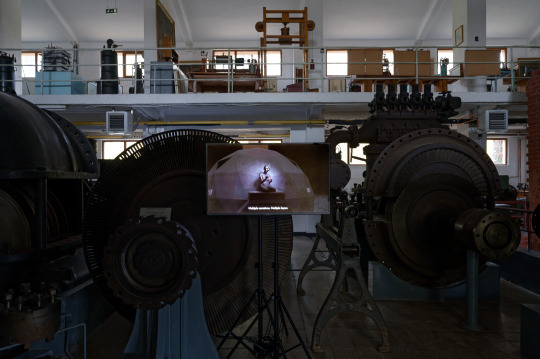


The Moons of Pluto (2021) András Cséfalvay & Lukáš Likavčan
Video 7:27 min
A collaborative work between visual artist András Cséfalvay and philosopher Lukáš Likavčan, The Moons of Pluto is an audiovisual commentary on the cosmological role of science. In the spirit of writer Sylvia Wynter, it recuperates the notion of the human as a storyteller and myth-maker as it surveys narratives about ancestrality and cosmic origins in the Western scientific-tradition, usually obscured by the modernist insistence on secular rationality. Elements of astronomy, physics, metaphysics and Earth-system sciences are enacted as planetological figures – the five moons of Pluto (Charon, Kerberos, Nyx, Styx, and Hydra) – whose stories weave together a web of associations that reflect on the cosmic background of the Western culture, and that of science as a discipline.
András Cséfalvay is a visual artist, digital storyteller, and mytho-poet from Bratislava, currently teaching at the Academy of Fine Arts in Bratislava. He studied painting and mathematics and wrote a dissertation on the usefulness and reality of fiction. He delves into the relationship between culture and technology and the political and ethical aspects of listening to non-dominant voices in world interpretation. His latest works look at the relationship between astronomers and indigenous peoples in constructing the Mauna Kea telescopes, the flight of dinosaurs as a technology for survival after extinction, and the reclassification of the planet Pluto. He is a receiver of the Oskar Čepan Young Visual Artist Price, a member of The New Centre for Research and Practice, and a co-founder of the Digital Arts Platform at the Academy of Fine Arts in Bratislava. Lukáš Likavčan is a Global Perspective on Society Postdoctoral Fellow and research affiliate at the Center for AI & Culture at NYU Shanghai. His areas of expertise cover philosophy of technology and environmental philosophy. He is the author of Introduction to Comparative Planetology (Strelka Press, 2019). Previously, Likavčan studied philosophy at Masaryk University and obtained his Ph.D. in environmental studies. He also held visiting research positions at Wirtschaftsuniversität Wien and The Hong Kong Polytechnic University; faculty positions at Strelka Institute for Media, Architecture, and Design as well as the Center for Audiovisual Studies FAMU in Prague.
0 notes
Text

BIOGRAPHY: From July 2013 to August 2023 David D. Perlmutter was dean of the College of Media & Communication (CoMC) at Texas Tech University. He received his B.A. (’85) and M.A. (’91) from the University of Pennsylvania and his Ph.D. (’96) from the University of Minnesota. He is the son of two professors and so likes to think of academia as his “family business.” Perlmutter has been described by a Chronicle of Higher Education editor as a “household name among American professors” because of the widespread readership of three decades of writings on academic careers and higher education processes for the Chronicle and other publications, including a book on promotion & tenure from Harvard University Press. His previous leadership positions include director, School of Journalism and Mass Communication, University of Iowa (2009 to 2013) and twice as associate dean for graduate studies. He is currently under contract to write a book on academic strategic planning for Johns Hopkins University Press.
His administrative achievements and metrics include co-designing several Ph.D. programs and supervising both professional- and thesis-track M.A. programs, on campus, online, and at distance locations, and an innovative Fundraising & Philanthropy Communication undergraduate certificate program (at Iowa). At Texas Tech, his college has seen unprecedented growth in all metrics, including diversity, rank of admitted students, graduate and undergraduate enrollment, offsite and online offerings, retention and graduation rates, grant applications, and multidisciplinary research partnerships. The college achieved its 2025 federal sponsored research funding goals in fall 2020, rising from $45,000 when he started to over $1.6 million in fiscal year 2020. Also in 2020, the college exceeded its private-giving target. CoMC was rated the highest ranked research unit at TTU among all units, including the humanities, social sciences, and STEM, by the Global Ranking of Academic Subjects (Shanghai Index). The online master’s program that CoMC started became the fastest growing graduate program in the history of Texas Tech. The college has achieved among the highest rates of retention and lowest times to degree for undergraduate students. CoMC started unique teaching partnerships with the Rawls College of Business and Texas Tech University Health Sciences Center’s School of Nursing. Perlmutter was consistently rated among the highest performing deans in the university by his faculty in the annual Faculty Senate survey ten years in a row. Perlmutter chaired the TTU search committees for successful hires of provost and three college deanships (Arts & Sciences, Libraries, Visual and Performing Arts). The college is also rated as “Top 20” for Hispanic Enrollment, which contributed to TTU’s recent attainment of HSI status.
Perlmutter is the author or editor of ten books on political communication, new media technologies, and higher education published by, among others, Palgrave, Oxford, and Harvard University Press. He also published several dozen research articles for academic journals. He was co-principal investigator for about $800,000 in grants through the Kansas Transportation Institute. At Louisiana State University, he edited a political communication book series and won two faculty awards, including the main campus-wide award for research, teaching, and service. He has been twice elected to chair the research committee of the Association for Education in Journalism and Mass Communication (AEJMC), one of his field’s leading professional associations.
For public engagement, Perlmutter ran several prominent programs at the Dole Institute of Politics at the University of Kansas. He served on the board of two university book presses. He also wrote a feature on “Managing with Millennials,” dealing with generational challenges in the workplace, for a business magazine. Perlmutter has been interviewed by most major news networks and newspapers, from the New York Times to CNN and ABC, and was a featured guest on “The Daily Show.” He was a keynote speaker at varying interdisciplinary and interprofessional venues such as a New England Journal of Medicine conference on medical education of the future, a U.S. State Department tour of Europe, the annual meeting of the major association for retired and emeritus faculty, and many promotion-and-tenure workshops at other universities. He regularly speaks at industry, academic, and government meetings and runs workshops on personal and institutional branding via social media, visual persuasion, and higher education issues including fundraising. He has served as an executive coach for universities and hospitals. He has been recognized for his leadership. In 2018, Perlmutter was bestowed with the Texas Tech President’s Excellence in Gender Equity Award for advancing gender diversity, inclusion, and equity in his college. In 2017, he was elected vice president of AEJMC by the membership and served a term as president in 2019–2020. In 2021, he was the keynote speaker for the National Conference of Academic Deans.
1 note
·
View note
Photo


1. Language of Flowers No.12 (2021) 2. Language of Flowers No.13 (2021)
Born in Xinjiang in 1993, Irpan Alimjan now lives and works in Beijing, China, where he graduated from the Third Studio of the Oil Painting Department of the Central Academy of Fine Arts in 2017 and from the Third Studio of the Oil Painting Department of the Central Academy of Fine Arts in 2020.
Most of Irpan's recent works revolve around his childhood, his family, and his longing for his father, and the composition, tone, and subject matter of these works have an immersive effect on the viewer especially if they are also from Xinjiang. Using the unique visual beauty found in Uyghur decorative arts and his own aesthetic understanding, he creates regional yet contemporary works using ethnic materials such as Etles silk. Irpan's works have been presented at major institutions and important art fairs in Beijing, Shanghai, and Guangzhou. (source)
8 notes
·
View notes
Photo

Image: Paula Vilaplana. Produced for the 13th Shanghai Biennale
The 13th Shanghai Biennale Bodies of Water November 10, 2020–June 27, 2021 Power Station of Art 678 Miaojiang Road 200011 Shanghai China www.powerstationofart.com Instagram / Weibo / YouTube / #ShanghaiBiennale / #BodiesOfWater
“The flow and flush of waters sustain our own bodies, but also connect them to other bodies, to other worlds beyond our human selves.” –Astrida Neimanis
The 13th Shanghai Biennale, Bodies of Water starts its in crescendo program convening artists, activists, scientists, thinks, and citizens at large to sense, discuss, and reconstruct wet-togetherness.
The Power Station of Art (PSA) is delighted to announce the opening of the 13th Shanghai Biennale, Bodies of Water. For the first time, the biennale will unfold as an in crescendo project, launching November 10, with a five-day program titled PHASE 01: A WET-RUN REHEARSAL.
Challenging the usual art biennale format, it will be the first stage of an eight-month extended program that will allow the artists, thinkers and curators contributing to the Biennale to develop their work in close collaboration with the City of Shanghai, its people, networks of activism, organizations, and institutions. Bodies of Water will culminate with the opening of PHASE 03: AN EXHIBITION on April 10, 2021.
The Biennale’s Chief Curator, architect and writer Andrés Jaque, and its curatorial team composed of You Mi, Marina Otero Verzier, Lucia Pietroiusti, and Filipa Ramos, are collaborating with the School of Philosophy of Fudan University, the Shanghai Institute of Visual Arts, and the multimedia network DOCU TV to run the five-day performed assembly, where lectures, debates, screenings, and workshops will turn the Power Station of Art into a space for bodily experimentation.
via e_flux
8 notes
·
View notes
Text
The Colorful World of Francesco Lietti
Defined by a creative style that’s rhythmic, patterned and high-contrast, Francesco Lietti is both a visionary and an idealist. His works are rendered in bold and highly saturated hues that capture the imagination in an instant. Lietti recalls his arrival in Asia as a fascinating moment filled with vibrancy, energy, and beauty of its people, landscapes, and cityscapes.
He encapsulates all senses in his painting allowing the experiences and adventures to be immortalized. Inspired by travel and discovery, he brings his views onto the canvas. Lietti immerses himself into the process through different in-depth stages of elements, layers and colors. His works are featured in private collections worldwide and his exhibition at the Taipa-Houses Museum provides a glimpse to a life akin to a kaleidoscope.
📷
Tell us about your journey from architecture to art.
I’m an architect and I studied in Milan. I also expanded my studies in Paris at the École des Beaux-Arts, La Seine, and also at the Clerkenwell College of Printing in London where I worked. I came to Hong Kong in 2006 and worked in an architectural firm for a few years. I’ve always painted since childhood and then on the side here, I’ve started doing residencies with schools. I do collaborative painting with educational institutions and it expanded to that, it usually lasts for a week and it’s been a meaningful venture for me. I am based here now and I saw an opportunity on this line of work and I am now a full-time artist (smiles).
How did you end up working in Macau?
The Italian Consulate is very generous with me. In this case, the consulate consulted with me and I thought it’s a great opportunity. I created a few new pieces for Art Macao and exhibited a few I’ve made already. I have a lot of paintings that were inspired by travels in Asia; some of the paintings are about Shanghai, India, Singapore and discovering destinations. I added a little bit of Hong Kong and a tribute to Macau, of course.
What do you think about Macau’s art scene?
I honestly don’t know much about it but I know it’s flourishing. I would definitely love to explore more. I also did a show in Sheraton Grand Macao Hotel a few years ago in cooperation with the Italian Consulate. They put a few pieces up for auction for charity and that was quite a remarkable event.
Have you explored Macau? What did you think about it?
I went to museums and explored amazing works of art. I go there at least once a year and visit Fernando of course. I have had many opportunities to explore Macau and Taipa and I love taking my time to just walk around.
What do you think about Macau architecture?
I like the sense of nostalgia. I like the old streets and the feeling of a historical setting. It’s reminiscent of old Portugal. I quite like the Grand Lisboa and Zaha Hadid’s Morpheus at City of Dreams.
How would you describe your art?
It’s abstract, naive, landscape and urban vision. But, I am becoming more realistic more recently and less abstract.
Who buys your artwork?
Mostly expats who want to bring back memories of Hong Kong to their home. I also get travelers who long for memories of places. I work on original paintings and I can be commissioned for specific pieces. All my works are one of a kind!
📷
How long do you take to finish a work of art?
It varies depending on the pieces, brief, size and other factors. If it’s less complex, I would be able to do two to three artworks in a month.
Tell us about your work of art in Macau.
It’s a little bit about the city as a whole. Macau spaces are not as dense as Hong Kong. I feature my favorite buildings while also combining the contrast of old Macau and modern casinos and hotels. I was trying to find an image in my mind based on my principles and eventually, I painted according to my experience. There are a lot of elements like the plazas, old houses and views from a certain distance that will hopefully enthrall spectators.
What is the goal of your artwork?
First of all, I tell the stories for myself and return to the memory and feeling that I truly enjoy. When I find people who share the same sentiments as I do, of course that’s even more gratifying. If you can see your story in my painting that’s what an artist aims to capture. I have created 344 artworks since I arrived in Hong Kong and my aim is to keep every piece unique in a certain way.
Is there any place you want to go to capture a place?
I particularly love Busan in South Korea but I would love to go somewhere in South America. Of course, India fascinates me very much.
Colors of Asia: Painting by Francesco Lietti is available on Amazon. The book is inspired by Francesco’s jaunts in Asia while creating a visual story of people, landscapes, and cityscapes. The book is priced at HKD $295.
Source URL: https://cutt.ly/Yv86qFT
1 note
·
View note
Text
Fashion in the time of COVID
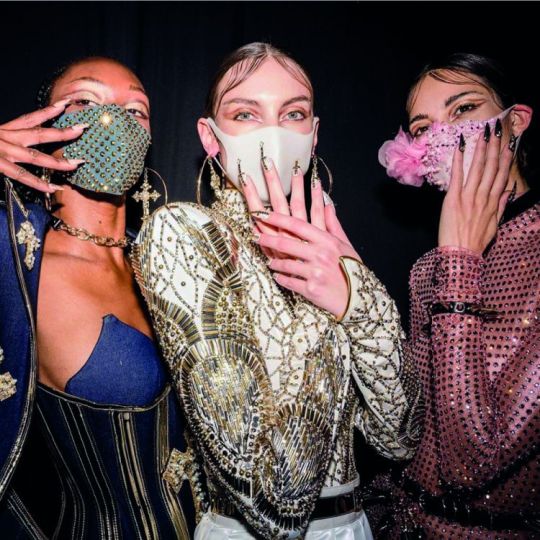
WILL THE PANDEMIC LEAD TO A MORE ETHICAL, SUSTAINABLE INDUSTRY?
"We went way too far. Our reckless actions have burned the house we live in. We conceived of ourselves as separated from nature, we felt cunning and almighty. We usurped nature, we dominated and wounded it."
Alessandro Michele, Creative Director of Gucci
Gucci's creative director Alessandro Michele posted 1,200 words of poetic, impassioned diary excerpts on Instagram, making one thing abundantly clear, Gucci, and possibly the fashion industry as a whole would never be the same again.
The COVID-19 pandemic hit the fashion world hard, gravely impacting all of its global capitals. Even before the virus struck, the industry was ailing. What happens now that no one's compelled to dress up from the waist down? And with our precarious place in the world coming into sharp relief, shopping for season “must-haves” seemed not only frivolous but immoral.
In March, Vogue partnered with the Council of Fashion Designers of America to set up A Common Thread, a pandemic-relief initiative that has raised $4.9 million to date. By May, more than 1,000 companies applied for aid, with even the biggest names on the precipice of an uncertain future.
In the interest of damage control, there has been industry talk of pushing the unreleased 2020 collections to 2021. It's curious that this requires we literally disavow the concept of fashion itself; that amorphous behemoth that tells us whether midi skirts are in or out this season.
With no end in sight to this state of flux, could this be an opportunity for the industry to ask itself some serious existential questions?
THE PROBLEM WITH FASHION
"We didn't respect the planet until now and in a way this [pandemic] is a message and unfortunately it's a very, very heavy message. Change had to be done. Everyone thought that the change would happen gradually, but that's not the case. Change has to be done now, and done quickly."
Sara Maino, Deputy Editor in Chief of Vogue Italia
Before the fashion world spiralled out of control, you had four seasons in the four major fashion capitals - London, Paris, New York and Milan. But the emergence of fast fashion accelerated the situation to a dizzying degree. Brands were sucked into the vortex of insatiable consumer demand. The pressure on luxury and high-street alike to drop new trends at higher speeds and lower costs had designers in a hamster wheel trying to outpace the copycats. "We were out of breath", admits Gucci’s Alessandro Michele, referring to fashion's unrelenting schedule of up to eight collections per year.
In her book, 'Fashionopolis: The Price Of Fast Fashion And The Future Of Clothes', Dana Thomas takes an unflinching look at the catastrophic environmental and human cost of this obsession with newness. Fast fashion refers to the production of masses of cheap, trendy clothes at breakneck speeds. Thomas refers to this as "a dirty, unscrupulous business that exploited humans and Earth alike".
Fashion is one of our biggest global polluters, "responsible for nearly 20 per cent of all industrial pollution annually" and "10 per cent of the carbon emissions in our air". Deep down, we knew our clothes often were made by desperate people in unthinkably dire situations; how could we forget the Rana Plaza disaster in Bangladesh that took the lives of more than a thousand factory workers? Meanwhile, the COVID-19 pandemic has made the human cost of fast fashion devastatingly clear. Crowded, unhygienic environments coupled with exploitative employment and a shady supply chain left brands with no accountability and employees with no pay.
According to Thomas, we buy five times more clothes than the previous generation, with the average garment being worn only seven times before being thrown on the scrap heap. There's no escaping the pangs of guilt that many of us experience with these suspiciously cheap garments. However, there is also no denying that slow fashion can be prohibitively expensive.
Should caring about the environment be a privilege afforded only to the haves, with the blame being placed squarely on the have-nots? And should the onus fall on the consumer to fix the deep-seated problems in the fashion industry or should corporations take responsibility for their exploitative behaviour?
THE SEASON OF DISCONTENT
"At a certain level, most of us were forced to make what the industry told us to make, but it's already proven that the industry is broken. We will now concentrate more on making what we want to make and how we want to make it."
Sonia Carrasco, Fashion Designer and Brand Owner
There are calls for reform, with designer Dries Van Noten urging leading industry figures to sign an open letter setting out some demands. Van Noten wants to reduce the number of runway shows, and the preposterous volume of clothing produced, and sell collections in real-time. That is: bikinis in S/S and coats in A/W. Have you ever been shopping for summer staples, only to find all the season's rejects already relegated to the sales rack? Fashion moves at its own pace darling, a pace at odds with customers' needs. Van Noten says this is about making collections "more environmentally and socially sustainable" with a move towards sustainability throughout the supply chain with less product, less waste and less travel.
Not that Chanel is paying attention, taking customers and press to Capri for its Cruise 2021 pre-collection in June, in the midst of the COVID pandemic. The French fashion house is resolutely old guard, announcing it will stick to six shows: two ready-to-wear, two couture, as well as cruise and Métiers d'Art. Chanel is not alone, with Dior also showcasing its cruise collection physically in Southern Italy.
In response to COVID-19, the British Fashion Council and the Council of Fashion Designers of America released a joint statement, echoing many of Van Noten's concerns. It urges brands, designers and retailers to slow down, with appeals for changes that will benefit customers, improve the wellbeing of the industry and have a positive effect on the environment.
FASHION IN THE TIME OF PANDEMIC
"I try to ask myself what is the meaning of my actions. It's a vital and urgent questioning for me, which demands a careful pause and a delicate listening."
Alessandro Michele, Creative Director of Gucci
The big players in luxury fashion produce between six and eight collections per year, spending an eye-watering amount of money on each show. But is fashion week, with all its excesses and spectacles, gone for good?
The pandemic has led to a cascade of reflection and introspection, and fashion's big players were not unaffected. Saint Laurent announced plans to '"take control of its pace and reshape its schedule". Alessandro Michele has reduced the number of Gucci shows from five to two, nixing both seasons and gender. He writes: "I will abandon the worn-out ritual of seasonalities and shows to regain a new cadence, closer to my expressive call. We will meet just twice a year, to share the chapters of a new story".
After the cancelling of June's men's fashion week in Paris, Louis Vuitton disregarded both the industry's European home-base and its calendar, taking its latest men's show to Shanghai, a big change that signals a significant move towards a consumer-first approach. Which makes perfect sense with shoppers from Asia, the Middle East, Africa and Latin America accounting for the bulk of luxury sales. Is it time to admit that Eurocentric fashion shows are so last season?
Many brands have gone "phygital", which is the somewhat awkward portmanteau describing the hybrid of physical space and digital technologies. With Shanghai and Moscow both fully embracing digital for their fashion weeks in March and April, and Helsinki adopting a purely digital format with innovations such as 3D shows. If more fashion houses go off-piste with localised, digitally amplified events, this could be the death knell for fashion week as we know it.
Another big IRL fashion event on the calendar is the Met Gala, an annual fundraising gala for the Metropolitan Museum of Art's Costume Institute in New York City, and the most-watched fashion/society event of the year. It's usually an occasion for a (very) select few to dress-up in response to the year's theme, in a grand display of fashion as art, with the results ranging from the sublime to the ludicrous. This year it was postponed.
The show must go on, as they say, and it was a group of Gen-Z internet kids known as High Fashion Twitter (or 'hf twitter', because they're too cool for CAPS) hosting the biggest fashion party of the year. On May 4th, instead of the exclusive, highly branded, extremely profitable, marketing opportunity the Met Gala has become, hf twitter brought us an inclusive online celebration of self-expression and diversity. Whether dressing themselves, collaging or using other visual means, the guests shared their 'looks' on Twitter with the hashtag #HFMetGala2020, taking fashion out of the hands of the establishment, if only for a day.
High Fashion Twitter is a loosely structured mix of fashion fans and aficionados, who share inspiration and knowledge while being vocal about industry issues such as representation, sustainability and accountability. And for the event, they purposefully excluded any brands they deemed problematic, such as those known for cultural appropriation.
FASHION AND SOCIETY
"I understand that, for many, the purpose of a fashion magazine is about escapism, about providing beautiful images of beautiful people in beautiful clothes […] But there are moments when this feels weird. And this is one of those moments."
Emanuele Farneti, editor-in-chief of Vogue Italia
The effects of a global disaster of this magnitude amplified many social justice issues, notably resulting in the backlash over tone-deaf comments from fashion brands about the Black Lives Matter Movement, or their conspicuous, deafening silence. There was nowhere for the industry to hide.
While taking any political stance wasn't de rigueur for most major fashion houses, it's now not only accepted but expected to be in touch with issues facing the wider community. In fact, for some, this out-of-touchness is seen as impossibly callous in a world confronted by human tragedy and economic devastation.
There have been attempts to meet the moment, with efforts such as Vogue's new web series "Good Morning Vogue", fashion's self-proclaimed "wake up call". If the last decade has shifted the discourse around issues such as racism and climate change, then the global pandemic has accelerated it.
FASHION GOING FORWARD
"Through the creation of less product, with higher levels of creativity and quality, products will be valued and their shelf life will increase. The focus on creativity and quality of products, reduction in travel and focus on sustainability […] will increase the consumer's respect and ultimately their greater enjoyment in the products that we create."
The British Fashion Council
Driven by a new generation of socially and environmentally conscious consumers who care where the things they buy come from and where they'll end up, brands have upped their sustainability game. And with the threat of this pandemic acting as a call to action for the fashion industry to slow down and scale down before we find our selves facing a much bigger existential threat.
COVID-19 has caused a significant shift in the mindsets of both brand and consumer, teaching us all to slow down and reset. And should this pass, the things we learnt to value, such as our health, our freedom and hopefully our planet, may eclipse our desire for any conveyor belt of trends.
4 notes
·
View notes
Text
Der Tod Comparison, part 2
Continuation from the Part 1
These are just my own personal initial impressions of each actor playing this role and their interpretation.
At this point, it is almost all of them, no matter how obscure. Counting together with part 1, there are 48 in total. There are a few others that are missing from this list, but try as I might, I was unable find any recordings of them. If anyone knows of any footage with any other Tods, and would be willing to help me find it, I would be forever in your debt. Also, Toho, please release recording with Furukawa, this is killing me.
Masaaki Uchino - an eldritch abomination, somehow masquerading in a human form. Lots of poorly hidden tentacles. The angels are not merely creatures under his control, they are part of him.
Takeda Shinji - He is a pan who is just down to fuck. A magnificent and fabulous diva, and don’t you forget it. Life? Death? He doesn’t care about anything like that. He only cares about his (massive) dick. (Ok, no, he is very good, just, seriously, his posture in every scene he is in)
Tamaki Ryo - took me a while to get a hang of this Tod or to warm up to him, because the portrayal is fairly stoic (and the wig looks like like someone tripped and spilled radioactive paint on it, several times), but this is a collector of souls. Someone who may not necessarily care all that much about the person he is collecting in principle, but the need to have them is paramount, and for that precious second that is spent wanting and trying to acquire them, they are the most precious thing in the universe.
Thomas Borchert - video is of terrible quality, but I guess the closest thing would be a vampire. Mostly indifferent, but occasionally rather campy, with a peculiar oral fixation.
Paul Kribbe - The single least romantinc portrayal, not even a pretense of care, not even as a means to an end. This is a malicious scepter that is hanging over the imperial family specifically and nothing but.
Felix Martin - Another one of the more of the less personal Tods. Very few emotions, either positive or negative, just a minor annoyance. Nor is he quite as ephemeral as Uwe, for example. Keeps modulating the key, not sure I like that.
Jesper Tyden - So very gentle. Sincere in his offers of peace, of absolution to those who are his kindred souls, they are his precious companions and he wants only the best for them. So gentle.
Steven Seale - has rather angelic voice. Wants to be kind (to those that are worth his time), but because he is like a spring under tension, it is rather difficult for him to do.
Olegg Vynnyk - Manipulative bastard. He is pulling strings behind the scenes, every once in a while content with toying around with them in person, but this world is of his own design, everything unfolding exactly as he wishes.
Oliver Arno - He is tired, so very very tired. He loves humans, almost desperately, but how many times has he been through this? Unable to break this vicious cycle, he is in the hell of his own making, yearning, begging, but fundamentally knowing that all his efforts would be for naught.
Martin Markert - Master manipulator. Doesn’t care about anyone, moreso, holds them in contempt, they bore him, they are all just pawns to him. How overjoyed he is at setting them on the path of ruin that they cannot see yet - he is there only for the entertainment factor and nothing else.
Christoph Aphelbeck - Edward from Twilight, there watching you sleep. (Need to find a full version of this)
Mester Tamas - A natural showman. He is used to everyone hanging on his every word, on his every whim being satisfied by hordes of excited followers. Doesn’t quite get it why anyone wouldn’t want to be with him. Utterly uninvolved in anyone’s life, just passing by, but happy to get the credit and the blame. Constantly drunk.
Nemeth Attila - Um. Within 0.2 seconds of meeting Sisi, he imagined to himself an idyllic future with exactly 2.5 kids and a dog, and the moment reality started deviating from that perfect plan, he vowed vengeance onto her, setting out to systematically ruin her life and kill her kids. Creepiness factor is off the chart, and really makes me feel for Elisabeth in a way I haven’t really before. The most amazing thing about it is that somehow this portrayal is not more common.
Dolhai Attila - Terrifying. Grim reaper in the truest sense - just give him a scythe and a hood, and he is pretty much all the way there. Overdoing it a bit, though, there is nothing even remotely subtle about him.
Stanley Burleson - very tactile, the number of times he initiated physical contacts is rather on the high end for other Tods. Very quick to alternate between gentle and caring, and a controlling bastard. Kind of bad at his job.
Addo Kruinzinga - A spirit of death? No, this is a spirit of a cat. You are comfortable to lie on, so you’d best accept the full weight of this animal on your solar plexus, causing you excruciating pain. He’d bring you dead mice and dead leaves, looking at you incomprehensibly when you scold him, and pushes that vase on the floor without breaking the eye contact.
Ryu Jung Han - Very terrible quality of the recording, so hard to say, but he didn’t seem to be particularly romantic or gentle to anyone. More like he wanted to use Elisabeth and Rudolf, but not sure for what.
Jeon Dong-seok - A lonely ghost that was was chained to the empire to do its bidding, and grows more and more vengeful over time. He gains strength to start breaking the chains, even though in order to do so, he has to do some things he wishes he didn’t have to. Unnecessarily pretty.
Aran Kei - One of a horde, one of many. She speaks for the angels, and acts on their behalf, their will, their connection to the world personified.
Yumeki Noa - Gentle and caring, almost doting on those she set her sights upon. Very invested in their demise, but wants to make sure they are comfortable in the process, like smothering them with a pillow.
Ranju Tomu - he has Seen Things. Empires come and go, he had a personal hand in destroying many of them, and getting into gear to crumble another one. Sometimes he wishes he didn’t have to, but that’s his job, after all. The best he can do is to destroy it for Sisi, condemning everyone’s soul but hers.
Aoki Izumi - Some people just want to watch the world burn, assuming there are matches you can find to play with (I know the full video of this production exists somewhere, but it’s been years since anyone who has it that I came across has been active - send help)
Yuzuka Rei - A sadistic bastard who thinks he is owned the world. Not quite as completely self absorbed as a few others, but pretty high up there.
Rukaze Hikaru - A gentle giant, lurking in the shadows, afraid of everything, barely aware of his own strength. Wants to find someone to share his toys with, gets a big boost in self confidence once he realizes that he is not the most messed up person in this play.
Alexandra Mikhaylovskaya - A powerful, vengeful god. Fate incarnate. Not a very charismatic or seductive portrayal, but certainly one of the more breathtaking ones.
Elena Sivkova - The tiniest angel of the night who just inherited the keys to the underworld. Quite lovely, and could certainly grow to rule it with the iron fist later on, but so far she is just learning the ropes.
Shanghai Institute of Visual Arts student (cannot find her name) - A very benevolent entity, a perfect gentleman. Distantly reminds me of Saeko, just not quite as dramatic, more self-composed.
Chuhun drama club student (ditto) - Less of a supernatural entity and more of a pop idol. Not particularly interested in the affairs of those around them, but involved in everything primarily because it’d look good for their image, and out of misplaced sense of ownership.
65 notes
·
View notes
Photo
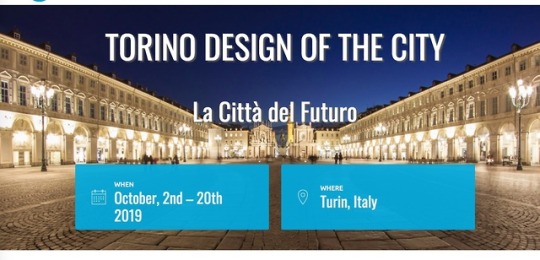
*Sounds fun, even with Google Translator.
Tuesday 1 October 2019 "Torino Design of the City" is back from 2 to 20 October, with over 80 events dedicated to accessible design
Turin Design of the City is back again in 2019 which, from 2 to 20 October, will lead you to explore new horizons, new themes and new relationships through a series of over 80 events organized by institutions, public and private cultural institutions, museums, theaters and libraries, dedicated to the theme of accessibility related to cultural structures, services and activities and focused on the opportunity to open up to new audiences and to work on their relationship with tangible and intangible cultural heritage.
The theme of Turin Design of the City 2019 is 'The City of the Future', chosen in close correlation with the Annual Conference of the Creative Cities of Fabriano, which took place in June 2019, and with the reflections conducted there with the cities sisters.
"Torino Design of the City 2019 confirms the creative-entrepreneurial vocation of our city" - said the Mayor of Turin Chiara Appendino - "Turin, which has become over the years a plural city, increasingly investing in innovation, research and internationalization, elements indispensable for the development of a territory, it is not new to events dedicated to the sector. Design, with its strong creative component, is therefore an important economic asset. It is culture, production, employment, industrialization, but it is also services. Within the general logic that concerns all aspects of design, the City has deepened the one dedicated to accessibility. In fact, design can be useful to redesign personal, cultural, environmental, urban, social services as well as those aimed at mobility. Topics to which our administration pays special attention ”.
It starts on Wednesday 2 October with a meeting and an exhibition at the renewed Circolo del Design, Torino Graphic Days, an international festival dedicated to visual Design. But the event of greatest resonance is the International Forum hosted on 10 and 11 October at the Polytechnic's Energy Center (via Paolo Borsellino, 38) which will be attended by representatives of the cities of Montréal, Detroit, Saint Ètienne, Kortrijk, Cape Town , Wuhan, Singapore, Seoul, Shanghai and London to share and deepen the projects that focus on the theme of accessibility and sustainability presented in response to the call launched by Turin at the XIII Annual Conference in Fabriano in June 2019. Part of the forum will be open to citizenship. while Thursday 3 October will be inaugurated on
"The goal we propose is the use of Design as a working methodology capable of giving shape also to unexpressed and latent needs, involving people as actors, together with technicians, stakeholders, to initiate or promote the birth of projects that redesign services, neighborhoods, places of the city, linking them with the red thread represented by the theme of universal accessibility and design for all "- declared Francesca Leon, Councilor for Culture of the City of Turin -" Torino Design of the City is not a festival, but a working method to build and stimulate relationships, collaborations and synergies at local, national and international level, promoting our creative, productive and entrepreneurial system of the Turin Design supply chain with attention to new experiences of innovation and digital technology ”.
The City of Turin will promote an international street-art meeting on 4th and 5th, also intended as a tool for urban regeneration. On the 16th afternoon, continuing the path begun last year, we will take stock of accessibility to museums and cultural institutions. Tuesday, October 15th, we will talk about public libraries of the future with the presence of professionals from the cities of Bremen, Helsinki, Madrid, Milan and Rome. The reflection will revolve around the role of public reading libraries in cities as squares of knowledge, space for comparison, meeting and discovery in the service of a growth of citizens' skills in the face of a world in constant evolution. The show will close on October 20 with Torino Stratosferica, the first City making festival in Italy. The program of the international review was carried out with the involvement and support of the Design Advisory Board - which involves over 47 public and private entities, including trade associations, training institutions, archives and museums - together and with the support of the Foundations Banking, the Turin Chamber of Commerce, the Turin Polytechnic and the University of Turin.
On the website www.torinodesigncity.it it is possible to consult and download the program.
1 note
·
View note
Text
Bottom plans
What are bottom plans? Bottom plans are scale delineations that show the relationship between apartments, spaces, and physical features viewed from over. They give a way to fantasize about how people will move through a space. bottom plans make it easier to check if the space is suitable for its willed purpose, work through any implicit challenges, and redesign before moving forward into further elaborate planning or structure stages. It can be delightful, too, to experiment with different design druthers and rotation overflows, which show how people move through a space.
Noted mastermind Jean Nouvel said, “ Space, space engineers always talk about space! But creating space isn’t automatically doing armature. With the same space, you can make a masterpiece or beget a disaster. ” That’s why from bitsy Houses to making a convention flow easily for attendees, a bottom plan is the place to begin creating and diagramming a logical space grounded on end-stoner conditions.
Bottom plans vs Erecting plans Bottom plans show the big picture of living, work, and out-of-door spaces. Although they should be scale delineations, bottom plans don’t hold enough information for builders to construct a home or other structures. rather, a bottom plan is a simple illustration caching room layout and offering an abstract starting point. A builder needs complete arrangements, or construction-ready delineations, with specialized information that you won’t find on utmost bottom plans. Space planning and rotation in new and being surroundings Space planning is important in new structures, but it’s also important in redefining spaces to determine how to use them more efficiently. Space planning has come into demand as a separate service by architectural enterprises for numerous reasons high-rise office space with untreated innards, the fast pace of organizational growth thanks to technological shifts, denting, and reorganizing. You can learn further about it in Space Planning, published by the American Institute of Engineers( AIA).
Rotation and business inflow In any space where people live, work, shop, or gather, the arrangement within apartments and the inflow from one space to another make a difference in the sense and mileage of the terrain. Good rotation and business inflow depend on what space is being planned — for illustration, in a retail space, you may want to direct the way callers move through a space, and in an art gallery, you may want a business to be less restrictive to help bottlenecks. Depending on the way square footage is divided, innards of the same size can feel veritably different depending on sightlines( a sightline is a theoretical line- of- the sight of a bystander to an object or area being viewed). As a rule of thumb, the smaller visual obstructions there are in space, the larger it’ll appear to be.
Flow and Feng Shui The idea of inflow doesn’t simply apply to the physical movement of people through space. Feng Shui, or the art and wisdom of creating a harmonious terrain, has been in use over1000 times to arrange private and public spaces. moment, Feng Shui interpreters all over the world use gauged bottom plans to design new structures or rearrange surroundings to correspond to the strict rules of the ancient practice. For exemplifications, the world’s newest Disney theme demesne in Shanghai has been erected after discussion with Feng Shui masters. You can learn further by reading Feng Shui Principles for Building and Remodeling in this stylish practices composition published by the AIA.
Seven ways to a creating a bottom plan to gauge for any space Whether you’re using paper, pencil, and graph paper to help you gauge, or an online program to draw up your bottom plan, there are some essential ways and particulars that go into the creation of a solid illustration List conditions. Make a thorough list of the requirements and wants of those who’ll enthrall the space.
Measure. Make sure you have the correct measures, so you may want to measure doubly. What to measure Outside walls or footmarks of your space, any doorways or entries, and windows.
The walls from side to side and from the bottom to the ceiling. Where the electrical outlets, switches, and other controls are located.
endless institutions all architectural features, including fireplaces, classes, shelves, benches, and any other erected-in features. Girding space and outside or overall confines of these particulars, and also detect each on your plan.
Objects that will be inside the space. Scale. bottom plans should be drafted to gauge, which means reducing the size of your delineation so the entire space can reasonably fit on a piece of paper or screen. A common scale is 1/4 inch = 1 bottom. This same scale should be applied to objects like cabinetwork or parade cells that will be included in the bottom plan.
suppose about sight lines. Standing, sitting, or working what do you want to see? suppose about windows, doorways, walls and what makes the utmost sense for the purposes you intend for the space. Render it. With all the factors in mind, organize your bottom plan.
estimate. Review the wants and needs list. estimate the spatial arrangement including assaying rotation. Other factors include usable space, sequestration, and availability. Learn further than about assessing space planning and design in domestic spaces. Share. unite and have someone additional look over your bottom plan to get helpful feedback to double-check your thinking and design.
Bottom plan layout exemplifications bottom plans are generally allowed as a first step in a home or office surroundings design, but these abecedarian plates are used for numerous other purposes, including theater plans, strategizing exigency exit plans, parking lot planning, and parade plans.
1 note
·
View note
Text
Week 5 - Research & Annotation
Aesthetic Features and its Artistic Impact of Ukiyoe
Suo, Li. (2013). Aesthetic Features and its Artistic Impact of Ukiyoe. Hundred Schools in Arts, S1, 136-137.
This text analyses and researches the style, philosophy and aesthetic characteristics of ukiyo-e painting from the perspectives of 'simplicity' and 'decoration', to understand the cultural perspective of people in the Edo period and appreciate the profound cultural connotations behind it, and understand the Japanese awareness of life and reverence for nature. The text was found in Google Scholar and is a journal article from Hundred Schools in the Arts.
I found this text worth reading as it is interesting in that the author discusses the influence of class and spending power of people, climate and geography on ukiyo-e in the Edo period (1603-1867), and details the connections between painting styles and culture. The author Li Suo is a professor at the School of Design and Art, Jingdezhen Ceramic Institute. She has published a number of academic papers in CORE journals and provincial professional journals, and has a relatively comprehensive study of the field. Considering the author's authority, I consider this to be a reliable resource.
Relevant to my field of enquiry and my practice, this article will deepen my understanding of the origins, styles and aesthetic characteristics of Japanese ukiyo-e, which I can then use more effectively in my future design practice.
The influence and inspiration of Japanese Ukiyo-e culture
Jiao, Ziying. (2008). The influence and inspiration of Japanese Ukiyo-e culture. Arts Exploration, 02, 44-46.
This text is about how Ukiyo-e was influenced by ancient Chinese paintings of ladies, novel illustrations, woodblock prints and colour overprinting, and combined the folk aesthetic of Japan. It developed into a uniquely Japanese national style and later influenced Western impressionism and post-impressionism. An aesthetic cult movement of Japanese culture emerged in the West, which made Japanese art a new aesthetic that transformed traditional painting in Western Europe. The text was found from Google Scholar and is a journal article from Arts Exploration.
I think this text is worth reading as it tells the story of the cultural origins and development of ukiyo-e that led to reflections on the influence of the Impressionist style in the late nineteenth century as the influx of Japanese artworks into Europe through trade, tourism and fairs. The author Ziying Jiao is a lecturer at the Shanghai Institute of Visual Arts and an MA in Fine Arts at the School of Art, East China Normal University, where he teaches and researches Western and Chinese art history.
This article is relevant to my field of enquiry and my practice, and after researching it I will be able to understand the aesthetic influences and national characteristics of Japanese ukiyo-e and increase my interest in this field of investigation so that I can use it more effectively in my future design practice.
Ukiyo-e: The Art of the Japanese Print
Harris, F. (2012). Ukiyo-e: The Art of the Japanese Print. Tuttle Publishing.
The text tells the story of Japan's rich history and way of life in Japan hundreds of years ago, and takes a thematic approach to this iconic Japanese art form, considering prints by subject matter: images of geisha and courtesans, kabuki actors, sumo wrestlers, eroticism, nature, historical subjects, and even foreigners in Japan. The book traces the evolution of ukiyo-e from its origins as a black and white illustration in the art culture of the metropolitan city of Edo to the elaborate two-colour prints and polychrome designs. The text was found from the AUT library as an e-book.
I found this text worth reading as it has detailed descriptions and examples of different types of Japanese prints (ukiyo-e) and will be very helpful in my research and design practice. The author Frederick Harris is a well-known American collector and artist who has lived in Japan for 50 years and is knowledgeable about the methods and materials used in Japanese printmaking.
0 notes
Text
Demystify the romance trope
New Post has been published on https://china-underground.com/2019/10/21/demystify-the-romance-trope/
Demystify the romance trope
Featured image: Installation view of Sun Yunfan & Dave Liang: Flashbacks in a Crystal Ball at Inna Art Space, New York (all images © Inna Art Space and courtesy Yufan Sun and Shanghai Restoration Project, all photos by Anyan Wu)
The romantic anecdotes of a collaborative couple are often more evocative than general stories about an artist’s inner growth.
Event site | Original music
They can act as mental opium to feed the nerves of those who feel abandoned to their lusterless fate. Just as people of the past used to seek therapeutic power through religion, today’s art practitioners and art lovers tend to consider art as a panacea helping them push through spiritual desolation.
It has the potential to connect them to like-minded souls, most ideally, to someone who can provide romantic comfort.
Understanding this, it is not surprising that a recent exhibition featuring visual presentation by a collaborative couple at Inna Art Space, titled Sun Yunfan & Dave Liang: Flashbacks in a Crystal Ball, could easily make a scene among the Chinese community in New York City.
This is in addition to the fact that the two artists also perform as an electronic music duo, Shanghai Restoration Project, popularized both in China and the United States due to skillful integration of romanticism and nostalgia into their music.
Shanghai Restoration Project was initially founded in 2006 by Dave Liang, a Chinese American who grew up in Upstate New York and aspired to create music synthesizing Western-leaning beat music with 1930’s Shanghai jazz. Compared to Liang, Yufan Sun’s navigation toward music was much more circuitous.
Born and raised in China, Sun relocated to the United States to pursue a master’s degree in accounting, though she eventually redirected her career to art. After earning a BFA from the School of Visual Art and an MFA from the Pratt Institute, Sun worked as a cultural journalist before joining Shanghai Restoration Project as a music producer and visual director at a relatively late stage.
Although Liang had been collaborating with different musicians and animators, it was not until he paired up with Sun that the band developed a much stronger chemistry between music and visual presentation, therefore expanding its influence to a larger circle of art lovers.
Yunfan Sun & Dave Liang, “Is it worth to believe that it will always get better?” (2019), ink drawing, guitar strings, baseball cards, and mixed media installation, 43 x 86 inch
Though the concept of “artist collaboration” is used as bait to trigger public curiosity for the show, the only collaborative artwork exhibited is an autobiographical assemblage that strings together the creative trajectories of both artists.
Despite the lack of legitimacy in terms of the format (as a two-person exhibition), the presentation of the show, in my eyes, does have an unexpected effect in discouraging the mindless mythologization of the romantic aspect of collaborative couples.
The exhibition showcases a series of enlarged prints of album covers designed by Sun, while sealing the music co-produced by the two within special edition cassettes and vinyl records.
This two-person exhibition actually functions more as a celebration of Sun’s contributions to Shanghai Restoration Project as an active agent and an affirmation of her identity as a visual artist alongside her pursuits in music.
Yunfan Sun, “R. U. R” (2017), archival pigment print, 20 x 20 inch
The illustration on a record sleeve never merely advertises the music, as the visual strength of the design supplements the lyrics in terms of communicating concrete ideas behind the music.
On the record sleeve of R. U. R, an album responding to Google’s DeepMind AI that defeated the world’s top Go champions, Sun reconstructs a chessboard into a labyrinth-like architectural space.
Above that, a hand, positioned like it is about to play a keyboard, approaches a chess piece to make the next move.
Deconstructing and recomposing different signifiers, Sun creates a visual puzzle indicating her presumption about the future relationship between art and technology; when the spontaneity of music composition and the complicated calculation of chess-playing both lose their original association with human intelligence, the apparent differences between the two intellectual activities will no longer exist.
In addition to the dichotomy between human and artificial intelligence, Sun introduces a third party: plants.
The chess pieces with binary code written in Chinese characters hang on two plants just like fruits growing from branches.
The circuit which connects individual chess pieces on the plant hints at the metabolism of natural substance, thus providing another potential reading of the image that contradicts an anthropocentric worldview: as the overwhelming binary logic is simply something rooted in genetic codes of natural substances, the victory of AI is an ultimate manifestation of a cosmology never fully understood by human beings since ancient times.
Visualizing such a complicated power dynamic among different elements requires a large amount of intellectual labor.
Yunfan Sun, “Dubalonia Radio International” (2018), archival pigment print, 16 x 16 inch
Moreover, the way Sun feeds the music with a modern interpretation of Eastern philosophy aligns with the Shanghai Restoration Project’s mission in integrating elements and ideas from Chinese culture into a Western form of music.
In Chinese art history, natural substances like plants and rocks were originally associated with a unified, omniscient cosmos. However, within the modernization and urbanization process started during the Ming Dynasty, there emerged a new genre of paintings depicting domestic space, within which plants and rocks always refer to feminine concepts such as sentimentality and melancholy.
Legitimizing biocentrism within a sci-fi setting, Sun seems to playfully suggest that plants always know more about the future than humans do, whereas humans constantly redefine the future by technology but ultimately lose their initiative.
With such an idea tapping into the paradox of human history, Sun elevates the status of plants, which are usually regarded as inferior to humans. By doing this, she empowers the cosmological expedition conducted within art, which appears to be less progressive compared to those heroic endeavors pushing technological development.
The overall sense of quietness and solitude that you can feel through Sun’s art does not mean that it is not aggressive.
Her visual strategy of juxtaposing unrelated objects to provoke deeper thoughts can be understood as a conscious resistance to an indolent mind.
The more time you spend with Sun’s images, the more you are going to believe that they appeal to the contemplative mind for deeper meaning rather than to the hungry eye for immediate satisfaction.
With such a self-sustaining ecosystem of creative forces, the seriousness and the artistic value surrounding Sun’s work should never be obscured by a romance trope due to her partnership with another artist.
Yunfan Sun, “Spooky Party” (2017), archival pigment print, 42 x 42 inch
#DaveLiang, #SunYunfan
0 notes
Text
Catherine Griffiths Overview
Installations / Interventions 2020 — »AEIOU« for HERE magazine, NZ 2020 — »intro/extro/vert« for Rectify This Painting, City Art Depot, Ōtautahi, NZ 2019 — »So far, a map of projects, a drawing«, as part of »catherine griffiths : SOLO IN [ ] SPACE«, The Space Gallery, Shanghai, CHINA 2016–2018 — »Kihi/Kiss«, carpet, Wellington Airport, NZ 2012-2018 — »Light Weight O«, O’Connell Street, Auckland, NZ 2017 — »Collidescape«, Te Kei, Ara Institute, NZ 2016 — »only U know«, Lela Jacobs, Auckland AW17, Paris SS17, NZ 2016 — A bespoke display system, New Zealand Institute of Architects, NZ 2014–2016 — Zion Hill Reserve, a pocket-sized park, Auckland, NZ 2016 — The Blyth Performing Arts Centre, Stevens Lawson Architects, NZ 2015 — »Constructed/Projected«, Typojanchi, Seoul, KOREA 2014 — typ gr ph c ........ a series of occasional workshops, Karekare, NZ 2012 — »Fifth Movement«, Takapuna Beach House, Auckland, NZ 2012 — »The Trestle Leg Series«, Auckland Harbour Bridge, NZ 2011 — »A Hillside Intervention«, Athfield Architects, Wellington, NZ 2011 — »Sound Tracks«, The Dowse, NZ 2010–2012 — Two studios + modest house, with Bruce Connew, Karekare, NZ 2010 — »The Jets«, short film, Paris, FR 2009 — »AEIOU, typo/sound installation«, Wellington, NZ 2005 — Distance markers, Wellington, NZ 2003 — Ponatahi, a house wrapped in a poem, Wairarapa, NZ 2000–2002/2004 — Wellington Writers Walk, 15 large-scale concrete text sculptures, NZ
Exhibitions 2022 — A Vocabulary, Bruce Connew, Te Kōngahu Museum of Waitangi, NZ (touring, design) 2021 — Poipoi Whakaaro, with ĀKAU for Toro Whakaara, CoCA, NZ 2021 — A Vocabulary, Bruce Connew, Toi Tauranga, NZ (touring, design) 2020 — A Vocabulary, Bruce Connew, Te Uru Waitākere Contemporary Gallery, NZ (design) 2020 — Rectify This Painting, curated by Eve Barlow, City Art Depot, NZ 2019 — »catherine griffiths : SOLO IN [ ] SPACE«, The Space Gallery, Shanghai, CHINA 2019 — »United Korea Flag«, Gwangju Design Biennale, KOREA 2019 — »Present Tense : Wāhine Toi Aotearoa« tour, multiple gallery/public venues, NZ 2017 — »JOHN SCOTT WORKS« (exhibition design), Objectspace, Auckland, NZ (design) 2017 — »So far, a map of projects«, transitionalfieldwork, Auckland, NZ 2017 — Shanghai Art and Design Exhibition, Liu Haisu Museum, Shanghai, CHINA 2016 — »A whakapapa, two lines of women«, All Lines Converge, Govett-Brewster, NZ 2016 — »Installation with mirror and line«, transitionalfieldwork, NZ 2016 — »Figures of Speech Display Stand«, Make Something, NZ 2015 — Typojanchi 2015, 4th International Typography Biennale, KOREA 2015 — The False Demographic, Blue Oyster Art Project Space, NZ 2015 — The Alphabet Project, Fitchburg, Massachussetts, USA 2015 — Fête du Graphisme 2015, City Poster Project, Paris, FR 2014 — The Hone Tuwhare Project, NZ 2012 — A View From Where I Was Sleeping, Dowse Art Museum, NZ 2012 — »memento :: motif«, Proyecto de Arte Contemporáneo Alzheimer, Chile 2011 — OLD SCHOOL/NEW SCHOOL, curated by Luit Bieringa, 125 years CoCA Massey, NZ 2011 — »Club de Conversation Keyholes«, Maquettes for the Floor, Dilana, NZ 2009 — New Zealand Identity: le cadavre exquis, curated by Leonardo Sonnoli, TypeSHED11 2007 — »Protest Vessel«, 1/2 Price, (collaboration), Norsewear Art Awards, NZ 2006 — Just Hold Me, curated by Jonty Valentine, Objectspace, NZ 2003 — Conversation Pieces, Michael Hirschfeld Gallery, NZ 2000 — Up:date//The Active Eye: Contemporary New Zealand Photography, PhotoForum
Collections Auckland Council Art Collection, Aotearoa NZ Christchurch Art Gallery, Ōtautahi, Aotearoa NZ Metropolitan Museum of Art Special Collection Library (books), USA National Hangeul Museum, Seoul, KOREA Shanghai University of Visual Art Museum, Shanghai, CHINA Special Collection at the Art Institute of Chicago (books), USA Stedelijk Museum, Amsterdam, NL
Published 2021 — »catherine griffiths: SOLO IN [ ] SPACE« A documentation, Pocca, CHINA 2020 — Dwelling in the Margins, Katie Kerr, Gloria Books, NZ 2019 — Self-Portraits, Art Zone, NZ 2014 — Art New Zealand #150, Body, Mind, Somehow ..., Gregory O’Brien, NZ 2013 — Lettering Large: The Art and Design of Monumental Typography, Steven Heller/Mirko Ilić, Monacelli Press, USA 2013 — Desktop, cover design and feature interview, Heath Killen, Australia 2013 — LetterScapes, Anna Saccani, Thames and Hudson, UK 2013 — New Graphic Design, The 100 Best Contemporary Designers, Fiell, UK 2011 — Typographic 69, The Australian Issue, ISTD 2009 — Small Studios, published by HESIGN, Germany 2007 — Typo — the beautiful world of fonts, Fabiola Reyes, MONSA, Barcelona 2006 — Lettere Nascoste (Hidden Letters), James Clough and students, Milan, Italy 2006 — Print magazine, feature, Life in Italics Helen Walters, USA 2003 — Artichoke magazine, feature, Writing by Types, Justine Clark, Australia
Writing 2020 — A Paper Vehicle, Catherine Griffiths & Bruce Connew, Dwelling in the Margins, NZ 2019 — Figures That Don’t Add Up, Eye Magazine Blog 2018 — 1997–2017, 43 Black Pins, 40 men, 3 women, The Spinoff 2018 — Peace, Word—Form 2015 — A meditation (Sir Ian Athfield, 1940—2015), Architecture Centre 2015 — typ gr ph c, Strips Club 2013 — FF ThreeSix (typeface review), Typographica 2012 — Truly No Idea, Desktop magazine 2012 — Look for the Purple Lining, Eye Magazine Blog 2011 — Shots in the Air, Eye Blog 2011 — John & Eye (feature), Prodesign 2011 — Quite a Blast (conference review), Prodesign 2009 — Locating Our Feet, TypeSHED11, Threaded magazine 2007 — Notes on Feijoa (typeface review), Prodesign
Lectures / Workshops / Community 2022 — upcoming: Workshop, 16 – 20 May, ISIA Urbino, ITALY 2021 — Speaker: in conversation with Pocca at Bananafish Books, Shanghai, CHINA 2021 — Speaker: Variation on a Theme [11:00h, 11 June NZT], Typographics NYC, USA 2020 — Kaitautoko: »Te Reo on the Streets« with ĀKAU and taitāmariki, Kaikohe, NZ 2019 — Speaker/Workshop: Upholding Te Tiriti and diversity in design, Designers Speak (Up) + Ngā Aho, Design for Social Innovation symposium, AUT, NZ 2019 — Speaker: Transformations, Parlour + University of Melbourne, AUS 2019 — Kaitautoko: »Ngāti Hine Pou Kōrero« ĀKAU Futures!, Taumarere, NZ 2019 — Kaitautoko: Basketball Court, ĀKAU Communities!, Kaikohe, NZ 2019 — Speaker/Workshop: Visual Narratives, School of Design, VUW, NZ 2019 — Panelist: Present Tense : Wāhine Toi Aotearoa, Enjoy Contemprary Art Space, NZ 2019 — Speaker/Workshop: »Solo in [ ] Space«, Shanghai Institute of Visual Arts, CHINA 2019 — Panelist: Present Tense : Wāhine Toi Aotearoa, Ilam Campus Gallery, NZ 2019 — Panelist: Present Tense : Wāhine Toi Aotearoa, Laurel Projects, NZ 2019 — Speaker/Workshop: Present Tense : Wāhine Toi Aotearoa, RAMP Gallery, NZ 2019 — Curator, organiser: Present Tense : Wāhine Toi Aotearoa project + exhibition, NZ 2019 — Speaker: Type Directors Club exhibition, St Paul St Gallery 3, AUT, NZ 2018 — Founder: Designers Speak (Up); co-founder, Directory of Women Designers, NZ 2018 — typ gr ph c ... #6, Format Limited, CG with Hamish Muir (UK), NZ 2017 — Speaker: Shanghai Art and Design Exhibition, CHINA 2017 — Speaker: CASS: A SERIOUS HOLIDAY, NZ 2017 — Tutor: Porto Design Summer School, PORTUGAL 2017 — Speaker: International Symposium on Typography, RMIT + NGV, AUS 2016 — Speaker: in conversation with Len Cheeseman, City Gallery Wellington, NZ 2016 — Panelist: PhotoBook NZ Festival, NZ 2015 — Speaker: Typojanchi 2015, 4th International Typography Biennale, KOREA 2015 — typ gr ph c ... #5, Speech Practice, CG with online guests (NL), NZ 2015 — Juror: Gareth Morgan flag competition design jury, NZ 2015 — typ gr ph c ... #4, work out work, CG with Tino Grass (DE), NZ 2014 — 2015 — Advisory Board: Typojanchi, pre-Biennale, KOREA 2014 — Speaker: Art + Book Symposium, opening lecture, Dunedin, NZ 2014 — Speaker: A Slight Return, (Graphic) Design School School Symposium, Cass, NZ 2014 — typ gr ph c ... #3, Friday the 13th, CG with Warren Olds (NZ), NZ 2014 — typ gr ph c ... #2, Stencil/Stencilled, CG with Paul Barnes (UK), NZ 2014 — typ gr ph c ... #1, A Type of Improvisation, NZ 2013 — Speaker: Think Outside, Design Minds, Asia Pacific Design Library, AUS 2011 — Speaker/Workshop: A Type of Improvisation, Design Assembly, NZ 2010 — Speaker: Together, Alone, Designers Speak National Tour, NZ 2009 — Curator/Co-organiser (with Typevents Italy): TypeSHED11, NZ 2009 — Speaker: Beautiful World of Typography, Govett-Brewster, NZ 2008 — Speaker: Alaska Design Forum, Anchorage and Fairbanks, USA 2007 — Juror: Typography, D&AD Global Awards, UK 2006 — Speaker: Arts Institute of Bournemouth, UK 2006 — Speaker: Fast Type, Slow Type, Birmingham, UK 2006 — Speaker: SPARK, International Festival of Media, Arts and Design, NZ 2005 — Organiser/Speaker: inaugural Designers Speak, NZ 2005 — Speaker: I live at the edge of the universe, ATypI Helsinki, Finland 2005 — Book reading and interview: Typeradio, ATypI Helsinki 2004 — Juror: 20under40 annual ideas competition, Architecture Centre, NZ 2003 — Juror: BEST Design Awards, NZ 2003 — Speaker: (x)periment, Adelaide, Australia 2002 — Speaker: Landscape Design Conference, Wellington, NZ 2001 — Panelist: Judging a Book by its Cover, Auckland Writers Festival, NZ
Teaching 2020 — 2022 Lecturer, full-time, Victoria University of Wellington, NZ 2019 — ongoing: Kaitautoko, Design Collaborator, ĀKAU Studio + Foundation, Kaikohe, NZ 2019 — Mentor, Womentor Programme, NZ/International 2017 — Tutor, Porto Design Summer School, PORTUGAL 2014 — 2018 typ gr ph c ... a series of occasional workshops, Karekare, NZ 1994 — present: Guest teaching, assisting and mentoring students, including workshops, lectures and portfolio assessments, NZ and international
Memberships 2015 — present: Advisory Board Member, Whitecliffe College of Art and Design 2008 — present: Member, The Printing Museum, NZ 2006 — 2014: Member, Type Directors Club, NYC 2006 — Professional Member, International Liaison Group Arts Institute of Bournemouth, UK 2003 — 2010: Professional Member, DINZ
Awards [up to 2017] 2017 — Finalist, The Gentle Hand + The Greedy Eye, Cornish Family Prize, NGV, AUS 2017 — Pinnacle Award, The Gentle Hand + The Greedy Eye, AGDA Awards, AUS 2016 — Judges’ Choice, The Gentle Hand + The Greedy Eye, AGDA Awards, AUS 2016 — Gold Pin, Local Architecture Awards Display Stand, Best Design Awards, NZ 2016 — Bronze, Zion Hill Reserve, Best Design Awards, NZ 2016 — Bronze, The Gentle Hand + The Greedy Eye, Best Design Awards, NZ 2015 — Winner, Bates Smart Award Media in Architecture, Parlour Guides, AUS 2015 — Shortlisted, ParlourLIVE!, Venice Architecture Biennale, Australia 2015 — Certificate of Excellence, »Self-portrait in C«, Type Directors Club, USA 2014 — Winner, submission for a pocket-sized park design, Auckland, NZ 2013 — Shortlisted, Point of Distance, Venice Architecture Biennale, NZIA 2013 — Bronze, »The Trestle Leg Series«, BEST Awards, NZ 2012 — Winner, submission for a light sculpture, O’Connell St, Auckland, NZ 2012 — Honorable Mention, »AEIOU«, Zgraf 11, Zagreb, Croatia 2010 — Gold Pin, »For the record«, TypeSHED11 book, BEST Awards, NZ 2010 — Silver, I Must Behave, artist book, BEST Awards, NZ 2010 — Bronze, »AEIOU, a typo/sound installation«, BEST Awards, NZ 2010 — Gold Medal, »For the record«, TypeSHED11, Pride in Print Awards, NZ 2009 — Best Cover, A Short History of Photography, BPANZ Book Design Awards, NZ 2009 — TypeSHED11 voted Best Design Event of the Year, Urbis Magazine, NZ 2008 — Finalist, Books, Stopover, D&AD Global Awards, UK 2006 — Recognition for Contribution to the Environment, Architecture Centre, NZ 2003 — Finalist, Typography, Wellington Writers Walk, D&AD Global Awards, UK 2003 — Winner, Environmental Graphics, Ponatahi House, BEST Awards, NZ 2002 — Winner, Environmental Graphics, Wellington Writers Walk, BEST Awards, NZ 2002 — Winner, STRINGER Award, Wellington Writers Walk, BEST Awards, NZ 1999 — Best in Show, On the way to an ambush, Strathmore Graphics Gallery Award, USA 1994 — Gold Medal, The $4billion Sheep, Pride in Print Awards, NZ
Clients (since 1995, as independent designer) ĀKAU Foundation / Ara Campus / Architecture+ / Architecture + Women A+W•NZ / Athfield Architects / Auckland City Mission / Auckland Council Public Art Team / BRANZ / Bruce Connew / Boffa Miskell / Creative New Zealand / CCS / Dance Aotearoa New Zealand / David Cohen / David Straight / Four Winds Press / Fulbright New Zealand / Gecko Press / Gecko & Co. / Hanne Johnsen + Gyldendal, Norway / Information Tools / Justine Clark / Kerstin Thompson Architects / Lela Jacobs / LOGAN Studio / MAHARA Gallery / Massey University Press / Medical Council of New Zealand / Minty Architecture / MORST (Ministry of Research, Science and Technology) / Objectspace / Naomi Stead / New Zealand Institute of Architects / Parlour: women, equity, architecture / Rachel Hurst / Random House NZ / REANNZ (Research, Education Advanced Network New Zealand) / Stevens Lawson Architects / Sydney Yoga Space / Victoria University Press / Victoria University of Wellington / Wellington Airport / Wellington Branch of the New Zealand Society of Authors / Wellington Waterfront Limited / Wellington City Council / Wools of New Zealand
(Griffiths, 2022)
Griffiths, Catherine. (2022). 00 The Typographer and Designer. Studio Catherine Griffiths. https://www.catherinegriffiths.co.nz/00-the-typographer-&-designer.html
0 notes